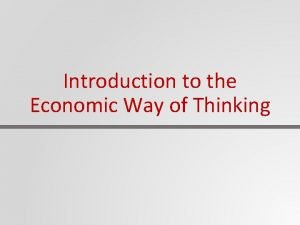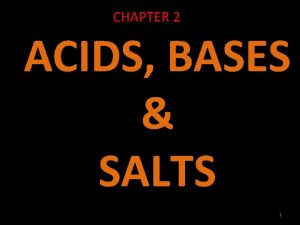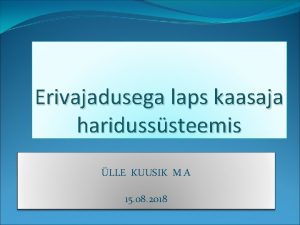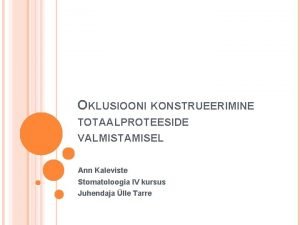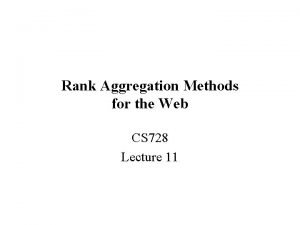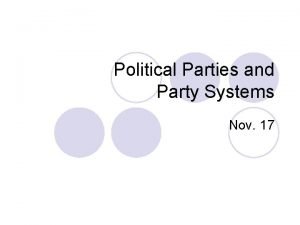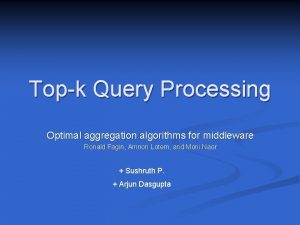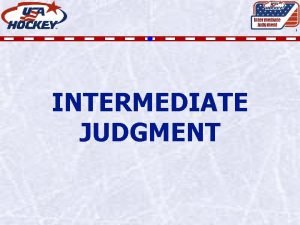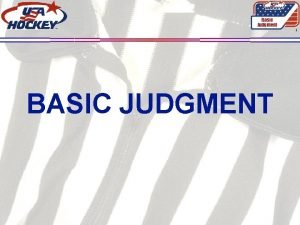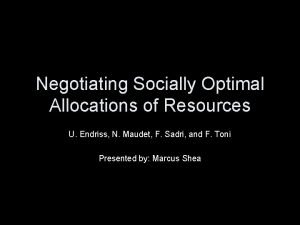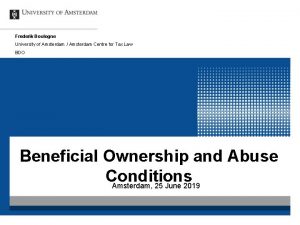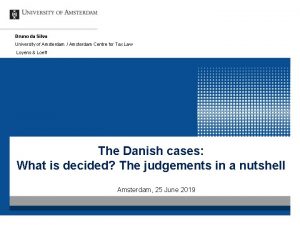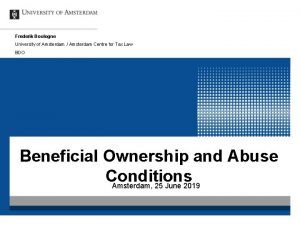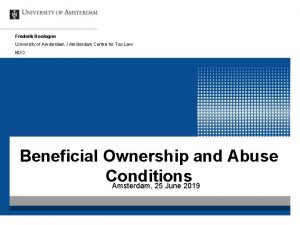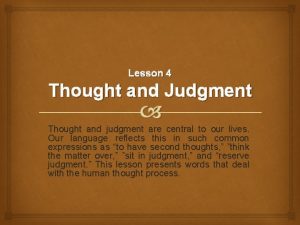Judgment aggregation acknowledgment Ulle Endriss University of Amsterdam
















- Slides: 16

Judgment aggregation acknowledgment: Ulle Endriss, University of Amsterdam Lirong Xia Oct 10, 2013

Your paper presentation(s) • Two parts – presentation: about 1 hour – discussion: 30 min • Meet with me twice before your presentation – 1 st: discuss content covered in your presentation – 2 st: go over the slides or notes • Prepare reading questions for discussion – technical questions – high-level discussions: importance, pros, cons 1

Last class: Fair division • Indivisible goods – house allocation: serial dictatorship – housing market: Top trading cycle (TTC) • Divisible goods (cake cutting) – n = 2: cut-and-choose – discrete and continuous procedures that satisfies proportionality – hard to design a procedure that satisfies envyfreeness 2

Judgment aggregation: the doctrinal paradox Action p Action q Liable? (p∧q) Judge 1 Y Y Y Judge 2 Y N N Judge 3 N Y N Majority Y Y N • p: valid contract • q: the contract has been breached • Why paradoxical? – issue-by-issue aggregation leads to an illogical conclusion 3

Formal framework • An agenda A is a finite nonempty set of propositional logic formulas closed under complementation ([φ∈A]⇒[~φ∈A]) – A = { p, q, ~p, ~q, p∧q} – A = { p, ~p, p∧q, ~p∨~q} • A judgment set J on an agenda A is a subset of A (the formulas that an agent thinks is true, in other words, accepts). J is – complete, if for all φ∈A, φ∈J or ~φ∈J – consistent, if J is satisfiable – S(A) is the set of all complete and consistent judgment sets • Each agent (judge) reports a judgment set – D = (J 1, …, Jn) is called a profile • An judgment aggregation (JA) procedure F is a function (S(A))n→{0, 1}A 4

Do we want democracy or truth? • Most previous work took the axiomatic point of view • Seems truth is better for many applications – ongoing work 5

Some JA procedures • Majority rule – F(φ)=1 if and only if the majority of agents accept φ • Quota rules – F(φ)=1 if and only if at least k% of agents accept φ • Premise-based rules – apply majority rule on “premises”, and then use logic reasoning to decide the rest • Conclusion-based rules – ignore the premises and use majority rule on “conclusions” • Distance-based rules – choose a judgment set that minimizes distance to the profile 6

Axiomatic properties • A judgment procedure F satisfies – unanimity, if [for all j, φ∈Jj]⇒[φ∈F(D)] – anonymity, if the names of the agents do not matter – independence, if the decision for φ only depends on agents’ opinion on φ – neutrality, [for all j, φ∈Jj ⇔ψ∈Jj]⇒[φ∈F(D) ⇔ψ∈F(D)] – systematicity, if for all D, D’, φ, ψ [for all j, φ∈Jj ⇔ψ∈Jj’]⇒[φ∈F(D) ⇔ψ∈F(D’)] • =independence + neutrality – majority rule satisfies all of these! 7

Example: Doctrinal paradox Action p Action q Liable? (p∧q) Judge 1 Y Y Y Judge 2 Y N N Judge 3 N Y N Majority Y Y N • Agenda A = { p, ~p, q, ~q, p∧q, ~p∨~q} • Profile D – J 1={p, q, p∧q} – J 2={p, ~q, ~p∨~q} – J 3={~p, q, ~p∨~q} • JA Procedure F: majority • F(D) = {p, q, ~p∨~q} 8

Impossibility theorem • Theorem. When n>1, no JA procedure satisfies the following conditions – is defined on an agenda containing {p, q, p∧q} – satisfies anonymity, neutrality, and independence – always selects a judgment set that is complete and consistent 9

Proof • Anonymity + systematicity ⇒ decision on φ only depends on number of agents who accept φ • When n is even – half approve p half disapprove p • When n is odd – (n-1)/2 approve p and q – (n-3)/2 approve ~p and ~q – 1 approves p – 1 approves q – # p = #q = # ~(p∧q) • approve all these violates consistency • approve none violates consistency 10

Avoiding the impossibility • Anonymity – dictatorship • Neutrality – premise-based approaches • Independence – distance-based approach 11

Premise-based approaches • A = Ap + Ac – Ap=premises – Ac=conclusions • Use the majority rule on the premises, then use logic inference for the conclusions • Theorem. If – the premises are all literals – the conclusions only use literals in the premises – the number of agents is odd • then the premise-based approach is anonymous, consistent, and complete p q (p∧q) Judge 1 Y Y Y Judge 2 Y N N Judge 3 N Y N Majority Y Y Logic reasoning Y 12

Distance-based approaches • Given a distance function – d: {0, 1}A×{0, 1}A→R • The distance-based approach chooses argmin. J∈S(A) ΣJ’∈D d(J, J’) • Satisfies completeness and consistency • Violates neutrality and independence – c. f. Kemeny 13

Recap • Doctrinal paradox • Axiomatic properties of JA procedures • Impossibility theorem • Premise-based approaches • Distance-based approaches 14

Next time (last lecture): recommender systems • Content-based approaches: based on user’s past ratings on similar items • Collaborative filtering – user-based: find similar users 15 – item-based: find similar items (based on all users’ ratings)
 Ceteris paribus
Ceteris paribus Acknowledgement slide
Acknowledgement slide Acknowledgment images
Acknowledgment images Acknowledgment
Acknowledgment ülle kuusik
ülle kuusik Niisutuskraav aasias
Niisutuskraav aasias Juhtimiskonsultatsioon
Juhtimiskonsultatsioon Geir ulle
Geir ulle Ann kaleviste
Ann kaleviste Amsterdam university library
Amsterdam university library Resource and cost planning
Resource and cost planning Proportional symbol map ap human geography
Proportional symbol map ap human geography Class diagram static class
Class diagram static class An aggregation relationship is usually represented as
An aggregation relationship is usually represented as Rank aggregation methods for the web
Rank aggregation methods for the web Interest aggregation
Interest aggregation Optimal aggregation algorithms for middleware
Optimal aggregation algorithms for middleware
